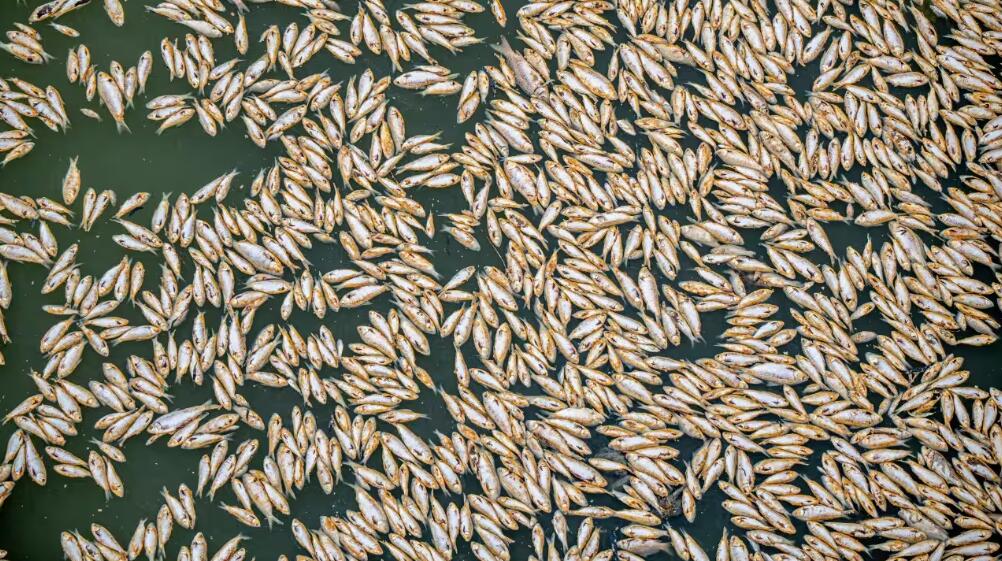Four years ago, millions of dead fish were found dead near Menindee, NSW. Now it’s happened again, with one expert pointing the finger at the state government.
As authorities continue the mammoth task of cleaning up millions of decomposing fish from the Darling-Baaka River at Menindee, NSW, locals have been left angry and confused – wondering how an environmental crisis of such scale could happen again.
Tensions spilled over during a town hall meeting in the far-western NSW town earlier in the week, which saw locals bring Water NSW authorities cups of river water, checking if they’d be game enough to drink it.
“’The water is safe; the fish kills are a naturally occurring phenomenon,’ is the line they keep giving,” said Menindee resident Graeme McCrabb.
Like almost everyone in the town, Mr McCrabb believes the real culprit is water mismanagement. And they’re not alone.
Haven’t fish died near Menindee before?
Yes.
In 2019 millions of fish died in the same stretch of the Darling-Baaka. The fish suffocated in disjointed pools of water during a record-breaking drought.
In 2023, the oxygen has been taken up by an increase in organic matter, swept into the river system after recent floods.

The fish died because of a lack of oxygen. Source: Supplied / Geoff Looney
The Murray Darling Basin Authority (MDBA) said, “while the scenes are distressing, comparisons should not be drawn between the current event and the one in 2018-19 which gave rise to the
Vertessy scientific review
.”
The review panel found low water flows, the inability of fish to easily move up and downstream because of weirs, poor water quality and sudden a change in temperature contributed to the fish deaths in 2019.
Expert accuses NSW of ‘sabotaging’ Basin Plan
Ecologist-turned-bureaucrat David Papps held the office of Commonwealth Environmental Water Holder (CEWH) from 2012, when the M
urray Darling Basin Plan
(MDBP) was first implemented, until 2018.
As CEWH, Mr Papps’ job was to manage billions of litres of water delivered by Basin states (NSW, Queensland, South Australia, Victoria and ACT) under the MDBP – to keep birds, fish, and wetlands healthy.
“What we’re seeing [in Menindee] is something is so frequent and so big that it is telling you something is fundamentally wrong with the management of the river system,” he told SBS News.
Mr Papps accused successive NSW governments of “sabotaging” the Basin Plan.
“What the NSW government is doing, and has been doing for a decade, is not blind incompetence. It’s a series of deliberate choices designed to sabotage the implementation of the Basin Plan,” Mr Papps said.
“For a decade, NSW has been choosing not to implement the parts of the Plan that disadvantage the irrigation community, while doing everything it can not to deliver water for the environment. And I would add that’s a view shared by most objective observers.”
Is NSW ‘sabotaging’ the plan?
Freshwater ecologist Richard Kingsford was part of the independent Vertessy review panel.
Professor Kingsford said while fish deaths after flood events are “not uncommon”, the scale of the situation at Menindee has been exacerbated by a “failure of water policy and water management”.
“Successive governments … have handed out too much water [to irrigators],” he said.
“This is the clearest sign of policy failure and also management failure. These catastrophes were inevitable.”
One of the Vertessy report’s key recommendations was to improve fish passages up and down the river system. That hasn’t happened.
“It’s been long known that Menindee does not have good fish passage, and with the Main Weir blocked off, the fish are essentially stuck, which is why they’re dying en masse,” Professor Kingsford said.
The MDBA said fish passages would not have helped in either fish kill, while the NSW government pointed to the so-called ‘Better Baaka Project’, which aims to improve river connectivity between the northern and southern Basin.
What does the NSW government say?
In February, the NSW government resubmitted almost all of its 20 water resource plans to the MDBA – four years late – after the Basin authority found the previous plans failed to meet basic requirements.
The NSW Water Minister Kevin Anderson said the Coalition has “worked tirelessly” to deliver the state’s water resource plans, “in a way that balances the needs of communities, water users and the environment.”
“NSW is responsible for 20 out of the 33 water resource plans, which is more than double the number of other Basin jurisdictions,” he said.
CEO of the National Irrigator’s Council, Isaac Jeffrey, rejected suggestions that irrigators received preferential treatment, claiming human needs like drinking water were prioritised.
“NIC supports healthy rivers, wetlands and wildlife, and that can be delivered through complementary measures and infrastructure investment,” he said.
“Just adding water through buybacks won’t deliver environmental outcomes.”
Where to from here?
At the Murray-Darling Ministerial Council meeting last month, federal water minister Tanya Plibersek announced the Albanese government would “buy back” water allocations on a voluntary basis to “bridge the gap” in environmental water not recuperated by state governments.
“At last month’s meeting, basin water ministers reaffirmed their commitment to achieving the Murray-Darling Basin Plan in full, including the New South Wales minister,” Ms Plibersek said.
But buybacks are controversial, the NSW water minister warning they would be “a massive blow” to Basin communities reliant on irrigation.
“NSW has been very clear on its position for more than a year: we need more time and greater flexibility to meet the remaining water recovery targets in the Plan through new and existing infrastructure projects,” Mr Anderson said.
If anything is clear from the past decade of trying to implement the Basin Plan, it’s that water policy is notoriously complicated and, at times, highly emotional, especially during drought.
It’s something Ms Plibersek is already bracing for, as the shift towards El Nino, which brings dry, hot conditions, begins.
“[Another drought] is coming, whether we like it or not,” she said at last month’s meeting.
“It’s our responsibility to make sure our communities, our farmers and our environment are all better prepared for that next drought.”
Promises for better preparation are cold comfort to Menindee locals, who have once again found themselves at the coalface of a boom-and-bust system, which is growing ever more extreme.


Leave a Reply